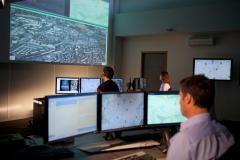- Author: Martin Böcker
- Contact: martin.boecker@airbus.com
The Border Security Control Room AdCoS employs the combination of novel proximity-based interaction technologies and adaptive support functionalities in order to increase the effectiveness and efficiency of emergency response operations. Work in border security control rooms is characterized by phases with high activity followed by longer phases with little or no activity. They are organized to allow a 24/7 operation. The control room sites are usually located close to the border and may be subject to assaults.
Currently, no mechanisms exist that ensure that operators are present at their workstations when the situation requires it. Neither are there adaptive and automatic functionalities for increasing the Control Room’s effectiveness by (semi-) automatic workload handover. Given the status quo, the AdCoS adaptation aims at increasing the emergency response organization’s effectiveness and security by implementing new adaptation functionalities. The AdCoS focuses on the operators’ physical and mental states, ensuring that they are present and effective when needed. Secondly, the organization’s effectiveness can be increased by optimizing the workload of each operator.
Five use cases for the Border Security Control Room AdCoS have been implemented:
- Operator presence / absence
In longer periods of inactivity, operators may be tempted to spend longer times away from their workstations. In the case of an emergency, they may not be immediately available, thereby increasing the Control Room’s response times to the emergency. The AdCoS uses infrared sensors in a Microsoft Kinect device to establish reliably whether an operator is present at his workstation or not. If his absence exceeds the permitted length of time (or in case of an incoming urgent case to deal with) the system will alert him discreetly by a vibration alert of his smartwatch to “nudge” him to return to his station.
- Operator idle / asleep
The AdCoS adaptation recognizes sleeping operators. If an operator has been identified as sleeping, the system will again activate an actuator to wake him up discreetly without anybody else noticing. This functionality is also realized with the help of the Kinect IR sensor and the smartwatch actuator device.
- Operator tired at his workplace
The level of fatigue of an operator is captured by means of an eye-tracker system. The sensors observe the movements of the operator’s eyelid and interpret specific eyelid behaviours as indicators of fatigue (PERCLOS parameter). The position of the operator’s head is measured by the Microsoft Kinect’s optical camera to provide the system with the information, at which times the operator is facing the screens.

Figure 1. The Border Security Control Room AdCoS - Interplay of optical camera and eye-tracking system (maintenance mode).
- Registration of unusual behaviour pattern
Regular and observable behaviour patterns can be exploited by perpetrators for scheduling illegal activities. For example, they observe that the operators always sit outside of the station playing cards at two o’clock in the morning and exploit this knowledge. The automatic recognition of such exploitable behaviour patterns can support the C2 Control Room management in identifying training needs for operators, focusing on behaviours that help maintaining the Control Room’s security.
- Load balancing at operator level
One way of improving the effectiveness of a C2 Control Room is the optimum distribution of workloads among operators. To just consider “objective” parameters such as number of cases to be dealt with is not sufficient, as parameters related to the individual operator such as level of expertise, level of fatigue and level of stress also affect the workload experienced by an operator at a given time. The AdCoS monitors the workload of each operator at any moment, visualizes the workloads to the supervisor, and pro-actively suggests the handover of individual cases from one operator to another if this improves the effectiveness of the operation as a whole.
Read more:

